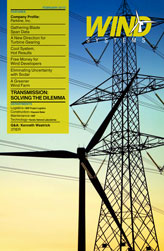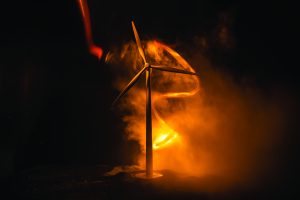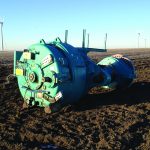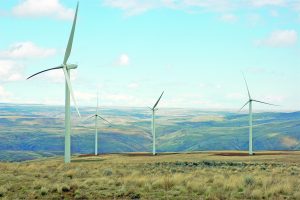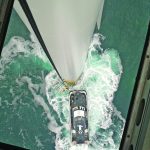Wind towers are not particularly heavy, but are subject to high lateral loads at a distance high above their base, resulting in a large overturning moment. This loading condition results in a downward load on the downwind edge of the foundation, and an upward load on the windward edge. Seismic loading, where applicable, further increases these overturning loads.
For shallow mat foundations, the downward load bears on natural or improved soils. The uplift load can be resisted by the weight of the foundation and additional surcharge placed above the footing. Increasing the mat diameter can also increase the resistance to the overturning moment. Deep foundation systems resist the moment couple by compression, tension, or bending of the deep foundation elements. When individual piles are utilized, the downwind elements resist the moment load in compression and the windward piles in tension. Tower foundations supported by a drilled shaft or a concrete cylinder are designed to withstand the moment in bending.
The uplift capacity of tower foundations can be increased by incorporating soil or rock anchors into the foundation system. Soil and rock anchors are tension elements which develop their capacity by bonding into soil and rock, respectively. Anchors are typically constructed by first drilling a 6- to 12-inch diameter hole into a stable soil or rock formation. A high-strength steel bar or strand (cable) is then placed into the hole, and the hole is filled with a high-strength cementitious grout. The top of the bar or strand is then attached to the foundation. When the foundation is subjected to an uplift load, the anchor resists the load by going into tension and transferring the load to the stable soil or rock formation. Soon after construction of an anchor, the soil-to-anchor or rock-to-anchor bond can be enhanced by pressure grouting the bond zone.
The design of the steel bar or strand is based on standard steel design with the appropriate factor of safety. Thread bars are available in 150 ksi steel with diameters up to 3 inches, providing an ultimate strength of 500 tons. Strands are available in 270 ksi steel. A single 0.6 inch diameter strand has an ultimate strength of about 30 tons. An anchor can be constructed with multiple strands, achieving over 1,500 tons. Typically the ultimate capacity of an anchor is limited by the strength of the soil or rock into which it is bonded. Anchors are available as a design/build service by specialty contractors.
By incorporating anchors into the initial foundation design, the foundation diameter, thickness and/or embedment depth can be reduced, potentially saving on the cost of the foundation. The anchors are located near the perimeter of the mat to maximize the overturning resistance per anchor. The foundation may require additional reinforcing steel to transfer the forces from the tower to the anchors.
Anchors can also be added to existing foundations (deep or shallow) that require additional uplift capacity. Again, locating the anchors at the perimeter of the foundation maximizes the moment resistance per anchor. The anchors can be installed through the existing foundation, and then the anchor head is bonded to the foundation. Alternately, the anchor can be installed adjacent to the foundation and then connected by dowels or an extension of the existing foundation.
Since anchors are a permanent part of the foundation, corrosion protection is an important aspect of the design. Corrosion protection is achieved through a variety of applications, including greasing and covering the steel, applying epoxy to the steel, or using galvanized steel. The grout surrounding the anchor steel provides protection from oxygen, and it is often supplemented with corrugated plastic pipe. The bars and strands can be ordered from the supplier already grouted into corrugated pipes. The corrugation provides the mechanical bond when the elements are grouted into the soil or rock.
Quality control measures include monitoring grout quality, quantity and pressure during grouting, and conducting load testing of installed anchors. Unlike traditional pile foundations where a limited number of piles are load tested, every anchor is load tested. Properly designed soil and rock anchors can provide an efficient and cost-effective component of a new tower foundation system or a remedial solution for existing tower foundations requiring additional uplift resistance.
















